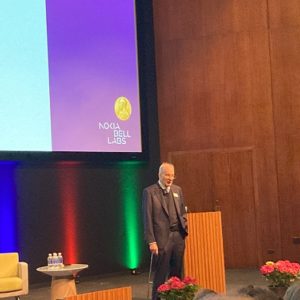5 Ways to Drive Lead Generation with Public Relations

Tech businesses today are faced with a lot of options on how they can create attention in a noisy marketplace. One of those strategies is a public relations program which can give your business a competitive edge.
It is common knowledge that public relations programs are deployed to build increased awareness of services, products, issues, trends and, particularly this year, political candidates. But did you know that PR can produce a high quantity of qualified business leads?
The use of PR to generate sales leads has reached new heights in the digital age. Businesses are no longer limited to hoping media outlets will cover their activities or attending trade shows to get the word out. The growing acceptance of social media and other digital marketing tools to support lead and business development has dramatically changed how PR can be used to drive sales growth.
Here are five ways that PR can support lead generation:
- Create Compelling Content—If the press release isn’t dead, it’s certainly on life support. Journalists cannot possibly keep up with deluge of press releases and e-mail pitches clogging up their in-boxes. Even if your press release or e-mail is one of the lucky ones to catch a journalist’s attention, if it doesn’t have any relevance to what he or she is working on or planning to work on in the near future, it’s got a one-way ticket to the round file.A small but growing number of companies have forsaken the time-honored press release and are creating their own content to engage current and prospective customers which can lead to new business opportunities. But the content isn’t focused on a new piece of software or hardware, instead it’s like reading or watching a story about an issue or trend that would make any bona-fide news organizations proud. In fact, much of this content is produced by former journalists who are working in newsroom settings at their companies. This content is not only posted on corporate websites, but it’s shared on social media channels, used for blogging purposes, repurposed for sales brochures and other marketing material, and parts of it are used in executive speeches.
- Media Coverage Builds Credibility – Press coverage not only produces enhanced visibility, it also brings credibility to businesses seeking to set themselves apart from their competitors. Favorable stories about your company that appear in a mainstream or trade publications can be what it takes to win the sale over press-shy competitors. Media coverage gives third-party validation to a company that can’t be done with advertising, direct-mail and other forms of marketing. And media coverage now has a longer reach, with stories being shared on a company’s social media platforms or linked back to the media outlet on their social media.
- Educating the masses – Go to any trade show and you’ll likely see a lot of sales people hanging around their booths talking to each other or playing games on their smart phones. And by chance an attendee stops by a booth, the sales person will give a brief pitch or product demo and then take their business card or scan their badge. That’s your typical lead generation at most trade shows.Rather than follow the crowd, companies planning on exhibiting at industry conferences need to use this opportunity to show everyone how smart they are. This can be accomplished by developing an educational program specifically designed for events, such as trade shows. People rather learn about new and exciting things, not sold to.However, be careful not to pitch your product during this educational exercise. Your audience should be sophisticated enough to understand that your company is selling a product related to the program, so no need to hit them over the head with it. Talk about lead generation, this will not only allow your company to position itself as thought leaders in its respective industry, but gives it the opportunity to build longer-term relationships with people who will visit the company’s website, follow on social media channels, subscribe to company newsletters, and other forms of engagement.
- Leave the bragging to the customer — Customer testimonials are a sure-fire way to grow sales leads. What can be more persuasive than customers talking about how your product or service helped their business. Pick a few of your best customers and ask them if they don’t mind saying a few nice things about your company or product. If they agree, offer to write the testimonial if they don’t have the time and show them the draft copy for their review. You may also ask them if they would agree to do a video testimonial which tends to make the message more impactful. These testimonials also can be repurposed for both traditional and digital PR tactics.
- Keep a Close Eye on the Competition-Ever wonder why your competitors are eating your lunch, dinner and breakfast? Perhaps, the first place you should check out is their PR/marketing strategies. Monitoring your competitors’ communications strategies would be quite smart and useful for your company’s lead-generation program. Do your competitors have an active editorial outreach campaign? You can bet they do if you start seeing stories about them plastered all over the place? Do your competitors have a strong digital presence? If the number of visitors to your company’s website, or followers on LinkedIn, or search engine page rankings pale next to your competitors, your company needs to step up its digital game. Are there hordes of people crowded around your competitors’ booths at tradeshows, while you and your colleagues are standing around your company’s booth looking bored silly? If so, that’s because they launched a PR program months before the event specifically designed to create booth traffic. Are your competitors’ senior managers often participating on industry panel discussions, while the CEO of your company is among those in the audience wishing, and maybe cursing, that he or she should have the same speaking opportunities? While it’s true a lot of trade shows sell speaking slots as part of the booth package, most of the heavily attended shows invite speakers based on their reputations as authorities on particular topics, rather than how much they can enrich the show’s organizers. And it was PR that crafted their reputations that opened the door to coveted speaking engagements.
The author is Marc Weinstein, CEO of Ascent Communications (www.ascentcomm.net), a marketing/public relations agency specializing in creating results-driven communications for technology companies.

